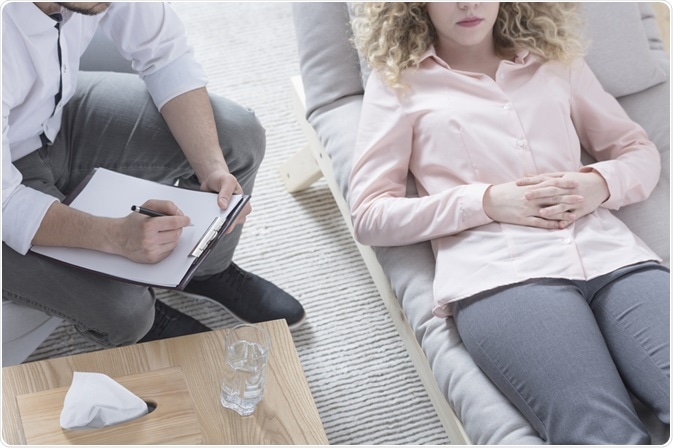In many cases of phobias there is no requirement of any therapy or treatment. Patients often find that avoiding the object of their fear is enough to control the problem.
 Image Credit: Desensitization / Shutterstock.com
Image Credit: Desensitization / Shutterstock.com
This is true for unnatural fears of objects that are not normally faced in everyday, such as the fear of animals, for example snakes. However, some fears like those of flying and closed spaces like elevators need to be treated as they may hamper with daily functioning.
Most phobias are curable but there are no single and simple approaches to dealing with these fears. Treatment of phobias includes counseling, psychotherapy and desensitization .
Counseling for phobias
In this method of treatment, a trained counsellor listens to the fears of the individual and helps them by talking therapies and tips to overcome such fears.
Often this involves discussing the impact that severe phobias may have on life and daily living and motivates people to seek self-help techniques or assisted therapy for treatment of phobias.
Psychotherapy for phobias
A psychotherapist delves deeper into the cause of the fear and helps to suggest ways to overcome the fears. Fear maintains fear and so does negative self-talk that is often seen in a phobic person.
Psychotherapy helps cut down upon these negative and pessimistic outlooks and helps cope with the fears. For example, those with a fear of flying may fear a plane crash. Such negative thought processes are addressed by psychotherapists and counsellors.
Cognitive behavioural therapy (CBT) for phobias
Cognitive behavioral therapy is a specific type of counselling that looks at thoughts, feelings and behaviour and suggests ways to overcome the fears.
In this therapy, the cognitive aspect teaches people to understand the thinking patterns that lead to their symptoms. For example, when the anxiety associated with phobia begins the sufferer may feel dizzy and feel impending death.
Cognitive behavioral therapy teaches the sufferer that this is just dizziness and not imminent death. There are a number of computerised cognitive behaviour therapy programmes as well that can help a person to deal with anxiety, phobias and depression.
Desensitization for phobias
Most of the simple and specific phobias are treated using this type of behavioral therapy. This is also called self-exposure therapy.
It involves being gradually exposed over a period of time to the feared object or situation. Due to graded exposure the anxiety tends to decrease over time. This type of therapy may sometimes be combined with medication for better results.
Virtual reality (VR) is helping in this area. VR allows patients to experience their fears in a safe place that they can behind leave at any time, and makes it easier to simulate experiences which are not necessarily common or easy to come across in everyday life.
 Image Credit: Monika Wisniewska / Shutterstock.com
Image Credit: Monika Wisniewska / Shutterstock.com
Medications to treat phobias
Medications are usually not needed or recommended for treatment of phobias as phobias are better managed by counselling and behavioral approaches. However, medication is sometimes prescribed for treating the effects of phobias like panic attacks and anxiety.
Antidepressants belonging to the group SSRIs (Selective Serotonin reuptake inhibitors) like Paroxetine (used in social phobias), Citalopram and escitalopram (used in panic disorders) and venlafaxine (used in generalised anxiety disorder).
Clomipramine is a type of tricyclic antidepressant and may be used in treatment of phobias. These may lead to side effects like headache, dry mouth, sleep difficulties, blurred vision, tremors, palpitations, constipation and nausea.
Moclobemide is another type of antidepressant that is sometimes prescribed to treat social phobia.
Another group of medications that may be used include tranquilizers. These include Benzodiazepines. They are used in therapy of anxiety disorders. They are only prescribed in the lowest possible dose for the shortest possible time. This is because they lose efficacy over time and may also lead to dependence.
Specific drugs include diazepam, alprazolam, lorazepan and oxazepam. These may cause some amount of drowsiness, sleepiness and tiredness.
Newer tranquilizers in use include Buspirone and Meprobamate. Like benzodiazepines, these drugs are only prescribed on a short-term basis.
A third group of drugs that may be used in phobias includes beta blockers. These are drugs like Propranolol that are used to treat high blood pressure. These act by reducing the heart rate and easing symptoms of palpitations.
Self-help techniques for phobias
Each patient needs an individualized self-help programme unique for him or her. These strategies may be drawn with the help from a mental healthcare specialist.
Self-help techniques include lifestyle changes, a course of cognitive behavioral therapy, being a part of a self-help group and attending sessions, using self-exposure or desensitization therapy or a combination of these approaches.
Lifestyle changes include healthy meals, regular exercise and relaxation and distressing strategies, sleeping adequately and reducing or avoiding caffeine and other central nervous system stimulants. Self-education about the fears and their impact on life as well as use of self-help books on managing and coping with fears also helps.
Those attempting de-sensitisation may try to gradually increase their exposure to their feared object or situation. For example, those with agoraphobia may start with small time periods at open spaces and public places and gradually increase the length of time and the distance from home.
Relaxation techniques include physical exercises involving breathing exercises. Yoga, meditation and other forms of exercises may also be tried. These relaxation techniques are often combined with visualization. The sufferer mentally visualises how they would deal with the anxiety- or fear provoking situation.
Meeting self-help groups and people with similar fears helps in finding ways to cope.
References
Further Reading